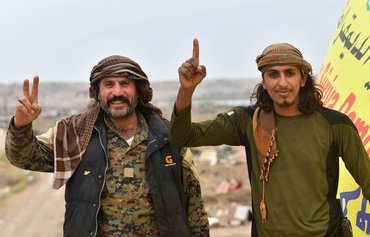Four years after the military defeat of the "Islamic State of Iraq and Syria" (ISIS), many Syrians say the battle against the group's remnants is far from over.
On March 23, 2019, the Syrian Democratic Forces (SDF), with international coalition backing, ousted ISIS from the Deir Ezzor village of al-Baghouz -- the final strip of territory it controlled in Syria.
The battle of al-Baghouz was a pivotal and significant victory in the war on terrorism, said media activist Ammar Saleh, who followed the battle's progress.
It did away with ISIS's last overt enclave and abolished its self-styled "caliphate", he told Al-Mashareq, putting an end to its "aura of invincibility".
![This picture shows a partial view of al-Baghouz in Syria's northern Deir Ezzor province, on March 24, 2021, as the village recovers from the ISIS occupation. [Delil Souleiman/AFP]](/cnmi_di/images/2023/04/18/41727-Baghouz-partial-view-600_384.jpg)
This picture shows a partial view of al-Baghouz in Syria's northern Deir Ezzor province, on March 24, 2021, as the village recovers from the ISIS occupation. [Delil Souleiman/AFP]
![Al-Baghouz is seen here in a screenshot from a video taken May 16, 2019, after the last battle took place between the SDF and international coalition on one side and ISIS on the other. [SDF Press]](/cnmi_di/images/2023/04/18/41728-al-baghouz-village-600_384.jpg)
Al-Baghouz is seen here in a screenshot from a video taken May 16, 2019, after the last battle took place between the SDF and international coalition on one side and ISIS on the other. [SDF Press]
It also underscored the importance of the ongoing alliance between the SDF and the international coalition in northern and eastern Syria.
Still work to do
Despite its significance, however, the battle of al-Baghouz did not achieve the total elimination of ISIS, Saleh said.
Numerous sleeper cells and "lone wolves" still stage sporadic attacks on civilians and SDF security personnel on the edges of al-Raqa and Deir Ezzor provinces, and ISIS remnants also intimidate civilians and try to extract money from them.
So far this year, more than 240 truffle hunters have been killed, mostly in ambushes by ISIS elements or in landmine blasts, in Syria's vast eastern desert (Badiya).
SDF ground operations, supported by international coalition air power, target the hideouts of ISIS remnants and their caches of weapons and equipment, Saleh said.
This has resulted in a noticeable decline in the number and destructiveness of ISIS attacks, he said.
The battle of al-Baghouz concluded a sad chapter in Syria's history, particularly in the country's north and east, where life has gradually returned to normal, Mahmoud al-Amin, a retired teacher from al-Raqa, told Al-Mashareq.
The battle against extremism is fought not only with weapons but also as local residents return to their land and resume normal life, he said, noting that the SDF local councils have achieved much success in this endeavour.
The SDF has been able to succeed despite the many difficulties it has faced, such as the sporadic attacks carried out by ISIS remnants, the remaining landmines and the lack of financial resources, he said.
The essential elements needed for a new start are now in place, he added -- such as infrastructure and internal security, health care and facilities that can be used as schools for the new generation.
Complex, ongoing battle
The battle to eliminate terrorism, specifically in Syria's north and east, is one of the most complex in modern history, SDF officer Farhad Khoja told Al-Mashareq.
It was highly unusual, he said, that a terrorist group had openly declared a state-like entity and populated a large number of extremist elements.
The fight against ISIS had to be precise because the group's fighters spread out widely among the civilian population and used it as human shields, he said.
Sleeper cells still exist because of the area's rugged and inhospitable terrain, which allow ISIS remnants to hide easily in places such as caves, he said. Some have found shelter in tunnels they dug out when ISIS was in power.
The attacks ISIS elements have launched in al-Raqa, Deir Ezzor and in the eastern desert since the battle of al-Baghouz indicate that the group is attempting to regroup in any way possible, Khoja said.
With these activities, ISIS is attempting to give the impression that it still has the necessary strength to continue its activities, he added.
Despite rumours that ISIS still has a large war chest at its disposal, however, the actions of its remaining fighters prove this is not so, he said, as they impose tributes on civilians and rob shepherds of their livestock in the desert.

![An SDF fighter stands guard on a road on the outskirts of the village of al-Baghouz in Syria's northern Deir Ezzor province, on March 24, 2021. [Delil Souleiman/AFP]](/cnmi_di/images/2023/04/18/41726-SDF-fighter-Baghouz-600_384.jpg)






